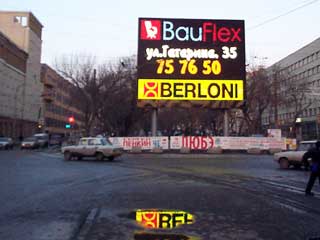“Outdoor Video” systems: News and views
 Large outdoor advertising lamp screen in Yekaterinburg (Russia)
Large outdoor advertising lamp screen in Yekaterinburg (Russia)Spring 2000 marks new and important developments in the area of large outdoor electronic video systems and new additions to large full-color screens in Europe and Asia. In February – March 2000, a large outdoor lamp screen with 9.14 m height and 12.16 m width image dimensions and 120x160 pixel resolution was installed in Yekaterinburg (Russia) and put into operation. So far this is one of the largest full-color screens in Russia and Europe.
Quite surprisingly, the outdoor screen proved to be more effective advertising media than even TV advertising. The screen was strategically located on the busiest intersection of major city streets where 90 percent of all city population passes at least once every week.
The efficiency of advertising was much boosted by the huge display of 9.14 m height and 12.16 m width that literally grabs attention of passers-by from the distance of 300-500 m. Thus, the contact period between the screen and viewers significantly increases.
The efficiency of the outdoor screen was so high that it rated a topic for an article in the popular car magazine “Klaxon” #6, 2000. Surely, according to the traffic rules drivers should not be distracted from the road by whatever happens to be around them – attractive commercials or a stunning girl. But pedestrians and passengers can look at the interesting bright advertising without breaking any rules and endangering traffic.
The growing number of TV and satellite channels naturally leads to the increasing efficiency of “large outdoor video screens”. At home advertising seems intrusive and people tend to switch channels during breaks for commercials. However, once outside people even welcome some diversion from waiting on a bus stop or in a traffic jam and absorb a lot of useful information without the opportunity to shift attention elsewhere. Thus, the once lost time is effectively filled with advertising.
It should be emphasized that screens are most effective in regional centers and cities with population from 150 thousand to 3 million since the architectural structure of such cities typically boasts a limited number of important intersections. Another development: an upgrade of a working screen on “Intourist” hotel was conducted. The upgrade works took two days without shutting down the advertising screen and was the first such feat in the history of outdoor screens. As a result, the brightness of the screen rose 30 percent.
This is an important professional achievement. These two companies have managed to create a new technology in the area of large outdoor screens that would allow easy upgrades of what was previously considered quickly aging and outmoded high-tech equipment.
The only available analogy can be gleamed from the history of PC development: the once closed systems (Altair 1974, Apple 1976, Commodore Pet 1977, RadioShack 1977, Osborne 1981 and others) were pushed out of the market by the open platform that allowed easy upgrades – IBM PC 1981 - and the market place of personal computers changed drastically in less than a year.





